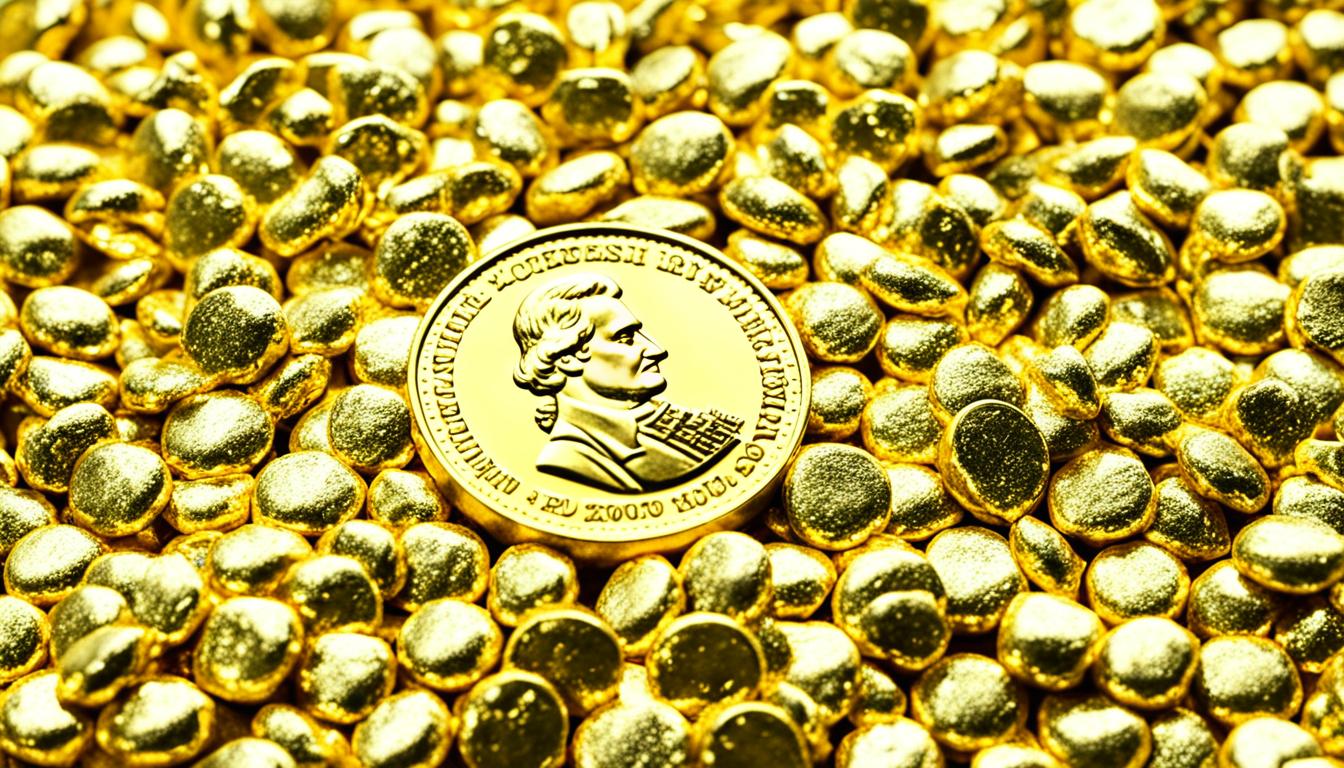Welcome to our informative article on the price of a gram of gold and gold rates. As a savvy investor, it’s crucial to stay up-to-date with the latest gold prices for making smart investment decisions. Knowing the current market value of gold allows you to seize opportunities and plan your investment strategy effectively.
Today, the average price of a gram of gold is €60.06 in EUR and $64.79 in USD, based on data from reliable sources. These prices can fluctuate due to various factors, including supply and demand dynamics, economic conditions, and currency exchange rates.
By keeping a close eye on the price of a gram of gold, you can seize favorable buying or selling opportunities, depending on your investment goals. Whether you’re considering gold as a long-term investment or a short-term trading opportunity, staying informed about the latest gold rates is a crucial step towards making informed financial decisions.
In the next sections of this article, we’ll explore other important aspects of gold investment, such as the price per ounce and per kilo, factors influencing gold prices, historical trends, and various ways to invest in this precious metal. So, let’s dive deeper into the world of gold and uncover valuable insights that will empower you on your investment journey.
Gold Price per Ounce
The price of gold per ounce is €1868.22 in EUR and $2015.29 in USD, as stated by the first source. They also mention the price in other currencies such as GBP and CHF. It is essential to keep track of the gold price per ounce as it is a widely used measurement in the market.
Investors and enthusiasts closely monitor the gold price per ounce as it serves as a benchmark for assessing the value of gold. Whether you are considering purchasing gold or evaluating the performance of your existing gold investments, knowing the current gold price per ounce is crucial.
Gold, often referred to as the “precious metal,” has been prized for its rarity and beauty throughout history. Its value has made it an integral part of many cultures, and it continues to hold significance in the modern financial world. Understanding the fluctuations in the gold price per ounce can help you make informed decisions and take advantage of potential opportunities.
When investing in gold, it’s essential to consider various factors such as market conditions, geopolitical events, and macroeconomic indicators. These factors can influence the supply and demand dynamics, which ultimately impact the gold price per ounce. By staying informed and keeping a close eye on the gold rates, you can optimize your investment strategy and potentially maximize your returns.
Gold’s value per ounce is not only important for investors but also plays a role in various industries such as jewelry, electronics, and dentistry. Therefore, understanding the gold price per ounce is relevant not only for financial purposes but also for practical applications.
In summary, the gold price per ounce is a significant indicator in the gold market. Being aware of the current gold rates allows investors, industry professionals, and enthusiasts to stay updated and make informed decisions. Whether you’re interested in buying gold, assessing investment opportunities, or tracking market trends, knowledge of the gold price per ounce is a valuable tool.
Key Takeaways:
- The gold price per ounce is €1868.22 in EUR and $2015.29 in USD.
- Knowing the gold price per ounce is crucial for investors and industry professionals.
- The gold price per ounce serves as a benchmark and a valuable tool for decision-making.
- Fluctuations in the gold price per ounce can be influenced by various factors.
Gold Price per Kilo
Investors seeking accurate information about gold prices per kilo can rely on the first source, which reports that the current price of gold per kilo is €60064.67 in EUR and $64792.96 in USD. These prices are subject to fluctuations depending on market conditions and other factors. It is essential for investors to closely monitor the gold price per kilo to make informed investment decisions.
Gold rates per kilo play a crucial role in determining the value of gold-based investments. As the price of gold per kilo changes, it can have a significant impact on the overall portfolio. Staying informed about the latest gold rates is vital for investors who wish to optimize their investment strategies.
Understanding the gold price per kilo is particularly important for individuals and institutions involved in large-scale gold transactions. Whether buying or selling gold in bulk, knowing the current price per kilo is invaluable for negotiating fair deals and maximizing profits.

24H Change in Gold Price
The gold price has experienced fluctuations over the past 24 hours, indicating the volatility of the gold market. According to the first source, there has been a change of 0.47% in EUR and 1.00% in USD. These price fluctuations highlight the importance of closely monitoring the gold market for potential investment opportunities.
It’s crucial to stay updated on the gold price change and understand the factors that contribute to these fluctuations. By keeping track of the gold market, investors can make informed decisions and take advantage of price movements to maximize their returns.
Factors Affecting Gold Prices
When analyzing the price of gold, it is crucial to consider the various factors that can have a significant impact on its value. The following factors play a key role in determining the price of gold:
Supply and Demand Dynamics
The supply and demand dynamics of gold are essential drivers of its price. When the demand for gold exceeds the available supply, prices tend to rise. Conversely, when the supply surpasses the demand, prices may experience a decline. Factors such as production levels, mining activities, and jewelry demand can all influence the supply-demand balance of gold.
Monetary Policy
The monetary policies implemented by central banks around the world can greatly affect the price of gold. Changes in interest rates, inflation targets, and quantitative easing measures can impact investor sentiment and the value of currencies. When central banks adopt accommodative monetary policies, investors may seek refuge in gold as a store of value, leading to an increase in its price.
Inflation Rates
Inflation rates can have a significant influence on the price of gold. Gold is often considered a hedge against inflation, as its value tends to hold or increase during periods of rising prices. Investors may turn to gold as a means of preserving their purchasing power when inflation erodes the value of traditional currencies or other financial assets.
Performance of Other Financial Markets
The performance of other financial markets, such as stocks and bonds, can impact the demand for gold. During times of economic uncertainty or market volatility, investors may flock to gold as a safe-haven asset, driving up its price. Conversely, when financial markets are booming and investor confidence is high, the demand for gold may decrease, leading to a potential reduction in its price.
By closely monitoring and analyzing these factors, investors can gain a better understanding of the forces at play in the gold market and make informed decisions regarding their gold investments.

Historical Gold Price Trends
Looking at the historical data from reputable sources, it is evident that gold prices have experienced significant growth over time, reaching all-time highs in various currencies. This trend highlights the enduring appeal and value of gold as a long-term investment.
Over the past five years, the price of gold has appreciated by approximately 36%. In comparison, the S&P 500, a popular benchmark for U.S. stock market performance, has seen a total return of 60% during the same period. Despite the strong performance of equities, gold has demonstrated its resilience and served as a reliable hedge against poor performance in other investment assets.
These historical gold price trends reflect the enduring allure of this precious metal. Whether it’s economic uncertainties, geopolitical tensions, or market volatilities, gold has consistently shown its ability to preserve wealth and provide stability during times of upheaval.
Gold as a Safe-Haven Asset
The volatile nature of financial markets and the potential for economic downturns make gold an attractive option for investors seeking a safe-haven asset. When other investments falter, gold has historically maintained its value or appreciated, serving as a reliable store of wealth.
Diversifying Your Portfolio
Investing in gold offers an opportunity to diversify your portfolio and reduce overall risk. Gold often exhibits a negative correlation with other asset classes, such as stocks and bonds. This means that when the value of one asset declines, the value of gold tends to rise, providing a balance to your investment portfolio.
By including gold in your investment strategy, you can mitigate the impact of market fluctuations and potentially enhance long-term performance. It acts as a valuable asset that can help preserve your wealth and protect against potential economic uncertainties.
Long-Term Performance
Gold’s long-term performance makes it an attractive investment option. While short-term fluctuations may occur, historical data demonstrates the potential for gold to act as a reliable store of value and protector against inflation over the long run.
As you consider your investment options, it is important to analyze historical gold price trends and evaluate the potential benefits it can offer to your portfolio. Remember to consult with a financial advisor to assess your investment goals and risk tolerance in order to make informed decisions.
Ways to Invest in Gold
Investing in gold offers a range of options to suit different financial goals and risk tolerance levels. Here are some popular ways to invest in gold:
- Buying Gold Bars or Coins: One common approach is to purchase physical gold in the form of bars or coins. This allows investors to directly own and store the precious metal. However, it is essential to consider storage and security arrangements.
- Investing in Gold Stocks: Another option is to invest in gold mining companies or exchange-traded funds (ETFs) that focus on gold-related assets. This provides exposure to the gold industry and its potential profits.
- Trading Gold Futures Contracts: For more experienced investors, trading gold futures contracts can be an option. This involves speculating on the future price of gold without owning the physical metal.
- Gold Funds: Mutual funds and ETFs dedicated to gold investments are available. These funds pool investors’ money to make diversified gold-related investments, providing easy access to the gold market.
Each investment option has its own benefits and considerations. For example, physical gold offers direct ownership and possession of the metal, while gold stocks and funds provide convenience and diversification. Consider your financial goals, risk tolerance, and investment preferences when deciding how to invest in gold.

Factors to Consider When Investing in Gold
Before making any gold investment, it is crucial to consider various factors:
- Market Conditions: Analyze the current state of the gold market, including supply and demand dynamics, price trends, and economic indicators that can impact gold prices.
- Investment Horizon: Determine your investment timeline and whether you are seeking short-term gains or long-term wealth preservation.
- Risk Tolerance: Assess your comfort level with potential fluctuations in gold prices and the volatility associated with different investment options.
- Costs and Fees: Take into account any associated costs and fees for buying, storing, and selling gold, as well as any management fees charged by gold funds.
By carefully evaluating these factors and consulting with a financial advisor if needed, you can make informed decisions about investing in gold and potentially benefit from its role as a valuable asset in your portfolio.
Benefits of Investing in Gold
Investing in gold offers numerous benefits, making it an attractive option for diversifying investment portfolios and safeguarding against market risks. Gold has long been regarded as a safe-haven asset, maintaining its value and even appreciating during economic downturns. Here are some key reasons why many investors choose to invest in gold:
Diversification:
Gold provides a valuable means of diversification, allowing investors to spread their risk across different asset classes. By including gold in a portfolio, investors can reduce their reliance on traditional investments such as stocks and bonds, as gold has historically shown a negative correlation with these asset classes.
Safe-Haven Asset:
During times of economic uncertainty or geopolitical turmoil, gold serves as a safe-haven asset. It acts as a store of value and a hedge against inflation, protecting investors’ wealth from market volatility. The enduring allure of gold as a safe-haven asset is driven by its limited supply and universal recognition as a valuable commodity.
Preservation of Wealth:
Gold has a long history of preserving wealth over time. Its intrinsic value and global acceptance make it a reliable store of wealth, particularly in periods of high inflation or currency devaluation. Unlike fiat currencies, gold cannot be easily manipulated by central banks or governments, providing investors with a tangible and stable form of wealth.
Portfolio Insurance:
Adding gold to an investment portfolio acts as a form of insurance against adverse market conditions. As gold often moves inversely to the stock market, it can help offset losses during market downturns, providing a level of stability and protection to investors’ overall portfolio. Its low correlation with other assets makes it an effective risk management tool.
Overall, investing in gold offers a range of benefits, including diversification, a safe-haven asset, preservation of wealth, and portfolio insurance. Incorporating gold into an investment strategy can provide stability, mitigate risks, and enhance the long-term performance of an investment portfolio.
Gold as an Inflation Hedge
Gold has long been regarded as a reliable hedge against inflation, offering long-term protection for investors. While the short-term effectiveness of gold as an inflation hedge may vary, studies have shown its ability to protect against inflation over decades or even centuries.
During periods of rampant inflation, the value of traditional currencies can erode, making gold a preferred alternative for preserving wealth. The scarcity of gold coupled with its inherent value has historically allowed it to maintain its purchasing power when other assets decline.
Investors should consider gold as part of a diversified portfolio that can provide stability and act as a safeguard during inflationary periods.
While it’s important to note that gold may not consistently outperform inflation in shorter timeframes, its long-term potential as an inflation hedge is significant. By holding gold assets, investors have the opportunity to mitigate the effects of rising prices and protect the value of their investments over time.
Gold’s historical track record as an inflation hedge is bolstered by its limited supply and its perceived value as a safe-haven asset. These factors make gold attractive for investors seeking to preserve capital and mitigate the negative effects of inflation on their portfolios.
Understanding the role of gold as an inflation hedge empowers investors to make informed decisions and utilize this precious metal’s long-term protective qualities to their advantage.
Conclusion
In conclusion, the price of a gram of gold is subject to fluctuation due to various factors, including currency exchange rates and market conditions. Investors should prioritize staying informed about the current gold prices, as well as analyzing historical trends and considering the factors that influence gold prices.
Investing in gold can offer valuable diversification benefits and serve as a safe-haven asset during times of economic uncertainty. However, it is crucial for investors to approach gold investment with careful thought and consideration of their individual financial goals and risk tolerance.
By understanding the dynamics of the gold market and conducting thorough research, investors can make informed decisions when it comes to incorporating gold into their investment portfolios. Whether used as a long-term hedge against inflation or as a means of diversifying their holdings, gold can play a valuable role in a well-balanced investment strategy.
FAQ
What is the current price of a gram of gold today?
The current price of a gram of gold is €60.06 in EUR and .79 in USD according to the first source.
What is the gold price per ounce?
The price of gold per ounce is €1868.22 in EUR and 15.29 in USD as stated by the first source.
What is the gold price per kilo?
According to the first source, the price of gold per kilo is €60064.67 in EUR and 792.96 in USD.
How much has the gold price changed in the past 24 hours?
The gold price has experienced a change of 0.47% in EUR and 1.00% in USD over the past 24 hours, according to the first source.
What are the factors that can affect gold prices?
Several factors can impact the changing price of gold, including supply and demand dynamics, central bank monetary policies, inflation rates, and the performance of other financial markets such as stocks and bonds.
What are the historical trends in gold prices?
According to the third source, gold prices have reached all-time highs in various currencies. Over the past five years, the price of gold has appreciated by approximately 36% while the S&P 500 has seen a total return of 60%. Gold has historically served as a hedge against poor performance in other investment assets.
What are the ways to invest in gold?
There are multiple ways to invest in gold, including buying gold bars or coins, investing in gold stocks, trading gold futures contracts, and investing in gold funds such as mutual funds or ETFs.
What are the benefits of investing in gold?
Many investors consider gold to be a safe-haven asset and a good hedge against market risks. Gold’s value tends to hold or appreciate during economic downturns, making it an attractive investment for diversification and protection of investment portfolios. Gold has historically shown a negative correlation with other asset classes.
Is gold a hedge against inflation?
Gold has been viewed as an inflation hedge over long periods of time, although its short-term effectiveness may vary. Studies have shown that gold can protect against inflation over decades or centuries, but its performance may be less consistent in shorter periods. Investors should consider their long-term investment goals when using gold as an inflation hedge.




